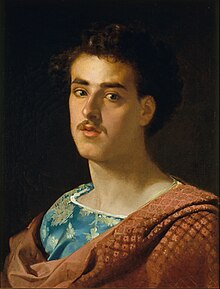Marià Fortuny
| Marià Fortuny | |
|---|---|

Self portrait by Marià Fortuny (1863-73)
|
|
| Born |
June 11, 1838 Reus |
| Died | November 21, 1874 (aged 36) Rome |
| Nationality | Spanish |
| Known for | Painting |
| Movement | Romanticism |
Marià Fortuny i Marsal (complete name Marià Josep Maria Bernat Fortuny i Marsal, pronounced: [məˈɾja ʒuˈzɛp məˈria bərˈnat fuɾˈtuɲ i mərˈsal]; in Spanish: Mariano José María Bernardo Fortuny y Marsal; June 11, 1838 – November 21, 1874), known more simply as Marià Fortuny or Mariano Fortuny, was the leading Catalan painter of his day, with an international reputation. His brief career encompassed works on a variety of subjects common in the art of the period, including the Romantic fascination with Orientalist themes, historicist genre painting, military painting of Spanish colonial expansion, as well as a prescient loosening of brush-stroke and color.
He was born in Reus, a town near Tarragona, in Catalonia, Spain. His father died when Marià was an infant, and his mother by the time he was 12. Thus, Marià was raised by his grandfather, a cabinet-maker who taught him to make wax figurines. At the age of 9, at a public competition in his town, a local painter, teacher and patron, Domènec Soberano i Mestres, encouraged further study. At the age of 14 he moved to Barcelona with his grandfather. The sculptor Domènec Talarn secured him a pension allowing him to attend the Academy of Barcelona (La Llotja school of art). There he studied for four years under Claudi Lorenzale and Pau Milà i Fontanals, and in March 1857 he gained a scholarship that entitled him to two years of studies in Rome starting in 1858. There he studied drawing and grand manner styles, together with Josep Armet i Portanell, at the Academia Giggi.
In 1859, he was called by the Government of the Province of Barcelona (Diputació de Barcelona) to depict the campaigns of the Spanish-Moroccan War. He went to Morocco from February to April of that year, making sketches of landscapes and battles, which he showed in Madrid and Barcelona when he returned. These would later serve him as preliminary sketches for his monumental piece, The Battle of Tetuan (La batalla de Tetuan, 1862–64, Museu Nacional d'Art de Catalunya, see next paragraph).
...
Wikipedia
